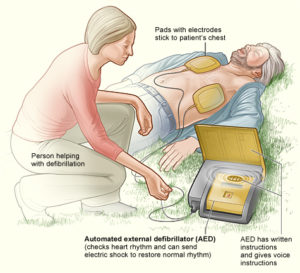AED Liability in Ohio
Posted in Accident & Injury, Health & Wellness on July 23, 2015
The Elk & Elk law firm is pleased to announce it has purchased an Automatic External Defibrillator (AED) for use in an emergency. This life-saving device is located on the first floor of our Mayfield Heights location, near the restrooms. Now employees, clients and visitors to the Elk & Elk building will have a better chance of surviving a cardiac arrest.
Cardiac Arrest
According to the Red Cross, sudden cardiac arrest is one of the leading causes of death in the United States. Over 350,000 people will suffer from sudden cardiac arrest this year. It can happen to anyone, anytime, anywhere and at any age. An AED is the only effective treatment for restoring a regular heart rhythm during sudden cardiac arrest and is an easy-to-operate tool for someone with no medical background.
Time is of the essence:
- The average response time for first responders once 9-1-1 is called is 8-12 minutes.
- For each minute defibrillation is delayed, the chance of survival is reduced approximately 10%.
Am I Liable?
People may worry they may be sued if something goes wrong while using an AED or performing CPR on an unconscious victim. Thanks to Ohio’s “Good Samaritan Laws,” people who voluntarily assist victims in distress are protected from litigation. Pursuant to Ohio Rev. Code §2305.23, individuals are protected from liability for providing emergency care outside of a hospital unless their acts constitute “willful” or “wanton” misconduct or are performed for payment. (Paid firefighters and police are exempt from this provision.)
In December 2014, lawmakers passed an Ohio bill, which shields building owners from negligence claims arising from AED use. The new automated external defibrillator law (O.R.C. § 3701.85) extends immunity to anyone who owns an AED machine and allows anyone to use the device, recommending training but not requiring it. Additionally, any person performing defibrillation is required to make a “good-faith effort” to activate an emergency medical system (call 9-1-1) as soon as possible. The law had previously required the person to activate the system.
AED Training at Elk & Elk
To help us start our new public access defibrillation program, Certified American Red Cross Instructor Laura Breese came to Elk & Elk to train volunteers from throughout the building to recognize a cardiac emergency and use the device to shock the heart into a regular rhythm.
Checking an Injured or Ill Adult
If you encounter an unconscious person, follow these steps before using an AED:
- Check for responsiveness. Tap their shoulder and shout, “Are you OK?”
- If no response, Call 9-1-1 and send someone to get an AED. If an unconscious person is face-down, roll him or her face-up keeping the head, neck and back in a straight line.
- If you are certified in CPR, begin while you wait for the AED.
- Open the airway. Tilt head; lift chin.
- Check for Breathing. Check for no more than 10 seconds. Occasional gasps are not breathing. If there is no breathing, perform CPR.
- Give 30 chest compressions. Push hard, push fast in the middle of the chest at least 2 inches deep and at a rate of at least 100 compressions per minute. Person must be on a firm, flat surface.
- Give 2 rescue breaths. Tilt the head back and lift the chin up. Pinch the nose shut and make a complete seal over the mouth. Blow in for about 1 second to make the chest clearly rise. Give rescue breaths, one after another.
- Do Not Stop. Continue cycles of CPR. Do not stop unless you find an obvious sign of life (such as breathing), an AED is ready to use, another trained responder or EMS personnel take over, you are too exhausted to continue or the scene becomes unsafe.
 Using the AED
Using the AED
- Turn on AED. Follow the voice and visual prompts.
- Remove all clothing from the victim’s chest and wipe the bare chest dry. Remove any medication patches. Shave away any excessive hair. Metal jewelry may be removed to prevent burns, but remember that time is critical.
- Attach pads. Place one pad on the right center of the person’s chest above the nipple. Place the other pad slightly below the other nipple and to the left of the ribcage.
- Plug in connector, if necessary. (Our AED does not require this step, but others may.)
- Stand clear. Make sure no one, including you, is touching the person. Say, “Everyone, STAND CLEAR.”
- Let the AED analyze the heart rhythm. Push the “analyze” button if necessary.
- Deliver shock, if advised. Make sure no one, including you, is touching the person. Say, “Everyone, STAND CLEAR.” Push the “shock” button, if necessary.
- Perform CPR if no signs of life. After delivering the shock or if no shock is advised, perform 2 minutes (5 cycles) of CPR and continue to follow the prompts of the AED. If at any time you notice an obvious sign of life, stop CPR and monitor breathing and for any changes in condition. If two trained responders are present, one should perform CPR while the other operates the AED.
AED Safety
- Do not use on children below 8 years or 55 lbs. unless using pediatric electrode pads.
- Do not use on conductive surfaces , such as water, fluids or metals
- Do not operate an AED if under the effects of alcohol or drugs
- Do not touch patient when shock therapy is being delivered
- Do not use in an explosive environment, e.g. oxygen enriched, gaseous or fume environment
For the complete Red Cross “Adult First Aid/CPR/AED Ready Reference” card, visit:
http://www.redcross.org/images/MEDIA_CustomProductCatalog/m28340131_Adult_Ready_Reference_Card.pdf